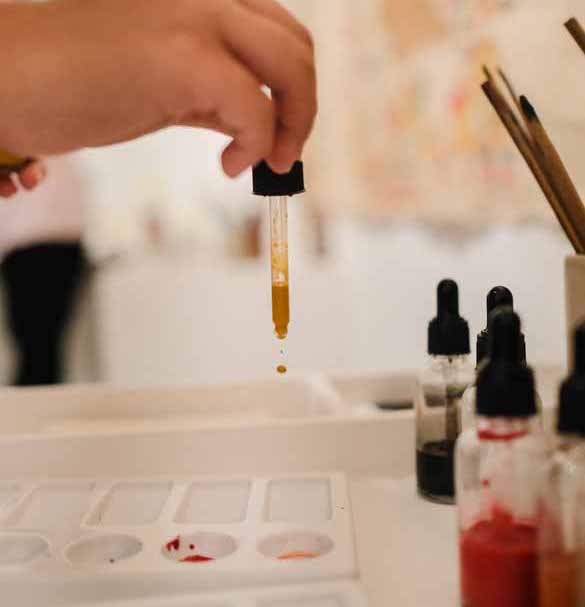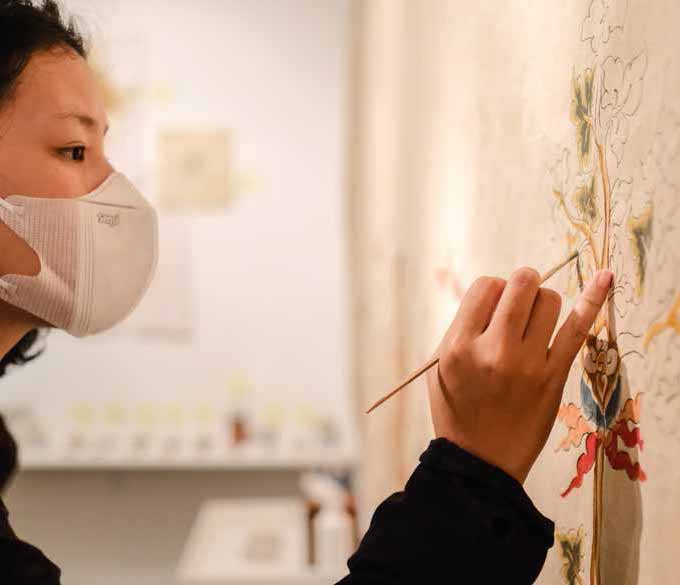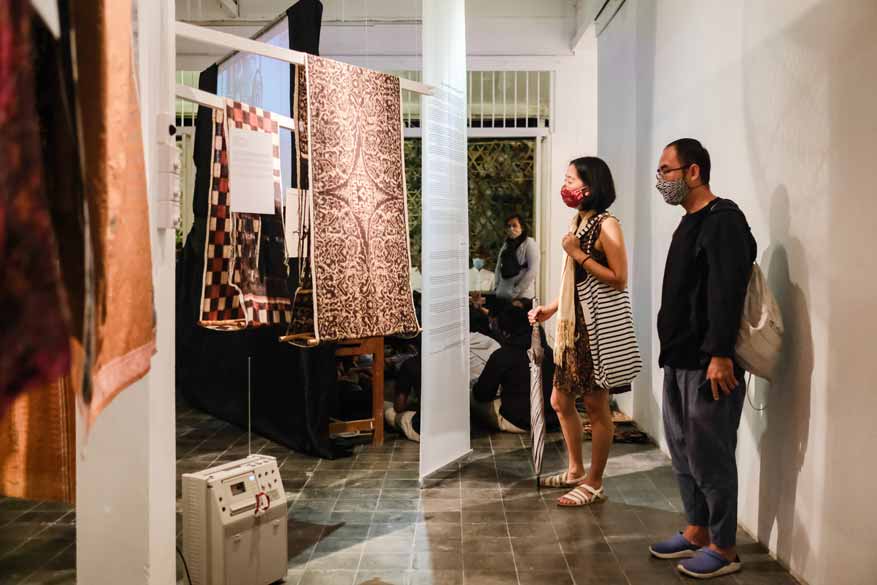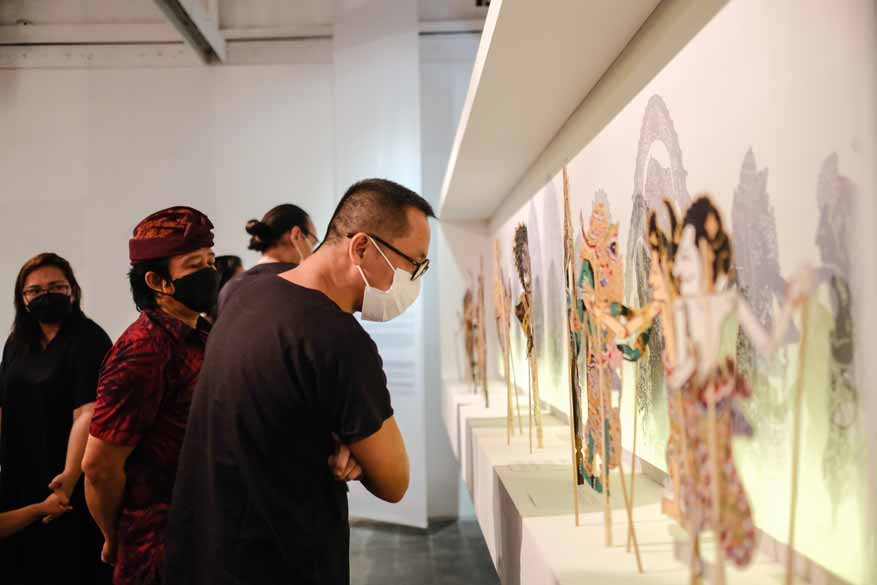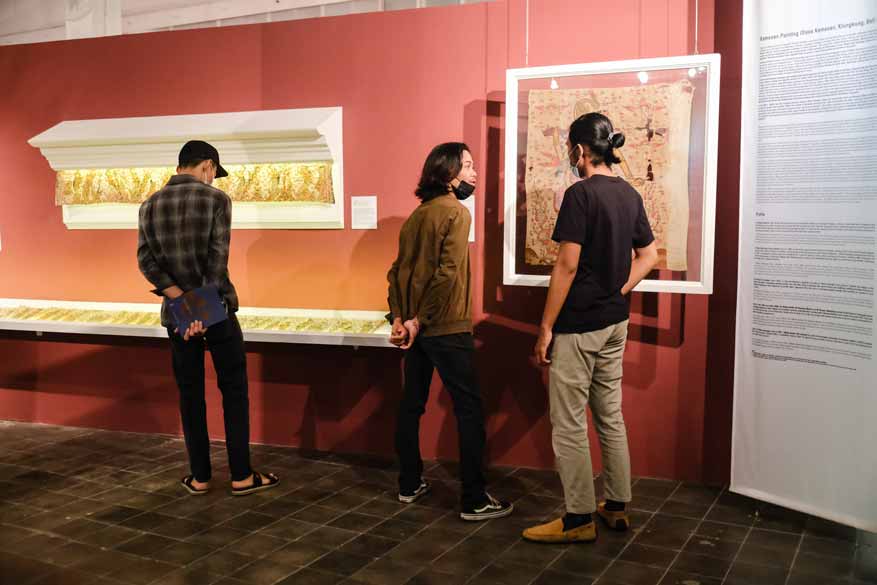Bali is an extraordinary sensory experience. Exciting and dynamic, as well as being tranquil and contemplative. Bali’s visual sphere is rich in colour, texture and form. Colour plays a vital role within the Balinese culture and identity – it is symbolic, while its origins are sacred. The Balinese traditional arts and crafts are derived from synergetic interconnectivity between humanity, the forces of nature and the cosmos, binding them within a divine unity.
‘Colors of Bali’, an outstanding cultural presentation and extensive research project on display at CushCush Gallery, Denpasar 4-19th December 2021, showcased the development of natural pigments and dyes in six traditional crafts of Bali. The crafts are divided into two categories. One is based on the visual language of Wayang, containing the Wayang Kulit Shadow Puppets; Topeng, ceremonial masks; and the Kamasan religious paintings which adorn the Balinese temples. The narrative source of these expressions is derived from the Hindu Buddhist epics like Mahabharata and Ramayana tales and the Panji folklore. The second category is the textile crafts of Gringsing, Cepuk and Songket, which have roots or are influenced by the ancient Indian textile, the Patola.
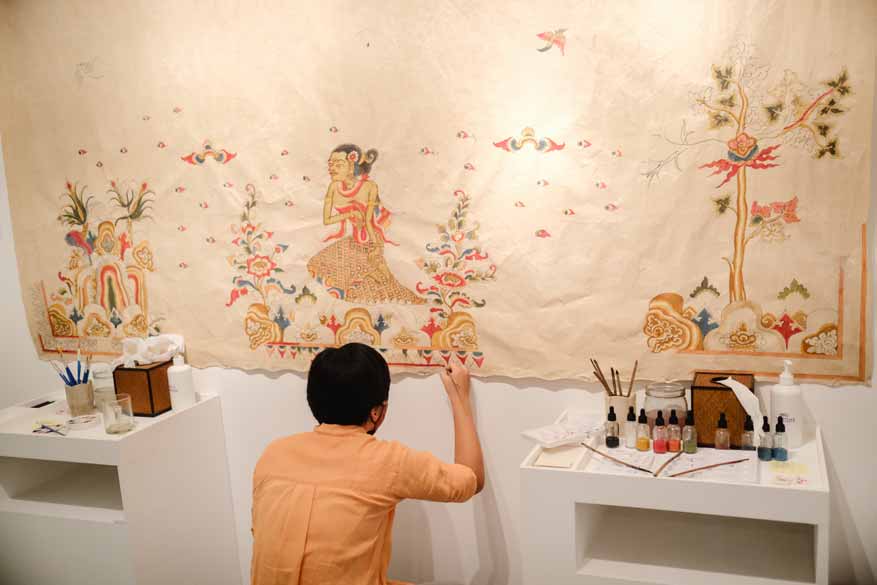
In ancient times, to help navigate and understand the often hostile natural environment, the Balinese learned to experiment with resources and knowledge drawn from the world around them. By integrating the rhythms, patterns and codes of nature, they innovated expressions that helped harmonise their inner and outer worlds and allowed transcendence. The crafts highlighted in ‘Colors of Bali’ were initially utilised for sacred ritual purposes as vehicles of communion with the spirits of nature and the Balinese ancestors and the gods.
Thirty-five works are beautifully showcased in ‘Colors of Bali’ along with insights from conversations, interviews, observations with respective artisans and people, research compiled in articles and books by academics, anthropologists, and researchers in their relevant fields to form a more holistic perspective on each of the crafts. An essential aspect of the exhibition is dedicated to the natural pigments and dyes which bring to life the arts and crafts through distinct and potent colour. Displayed are the raw materials along with photographs and text, allowing a coherent understanding of their origins, the individual refinement processes, and the distinguishing technical attributes within their applications.
The accompanying exhibition catalogue, documentary film and series of online workshops presented within the ‘Colors of Bali’ program culminate from an extensive research project led by CushCush Gallery (CCG) co-founders Suriawati Qiu and Jindee Chua. CCG began in 2016 as a platform dedicated to multidisciplinary collaborations merging fields such as architecture, communication design, interior design, product design and arts, including traditional performance and crafts. With an emphasis on children’s and local, national and international community learning, CCG’s philosophy addresses ‘Creative Education, Creative Collaboration, Creative Community’.
“The pandemic has had a disruptive impact upon Bali’s economy and the livelihoods of many. However, it did allow us time last year to travel to several districts and villages in Bali. A brief conversation with weavers in Tejakula, North Bali, reminded us of Bali’s many dying crafts, heavily dependent upon tourism,” ‘Colors of Bali’ curator Suriawati Qiu told me. “We pondered upon this and what was at stake, and from there, the seeds of ‘Colors Of Bali’ were sown: a journey of learning and discovering natural dyes and pigments in Bali’s traditional crafts.”
Artists and cultural practitioners included in ‘Colors of Bali’ are the late master Kamasan painter I Nyoman Mandra (1946-2018), I Made Sesangka Puja Laksana, Ni Wayan Sri Wedari, Ni Made Kartini, Ni Nyoman Mandri, Ni Wayan Jempiring, I Made Danan Adi Laksana, Cokorda Raka Sedana, Cokorda Putra Wiyuda, I Wayan Nartha, I Ketut Sudiana, the internationally renowned cultural expert from the Bali Aga village of Tenangan, I Nyoman Sadra, I Putu Wiadnyana, I Nengah Sadri, Ni Kadek Trisnawati, Ni Wayan Sari, Cokorda Sawitri, and the late Ida Swarga Ida I Dewa Ayu Alit, Ida Ayu Ngurah Puniari, and Ni Ketut Astiti. Many of these people attended the opening of the exhibition which was a celebration of human ingenuity.
A series of online and offline public events, including artisans-led workshops, curatorial tours and discussions held within the duration of the exhibition allowed the global audience to engage in the inspiring journey of discovering the Colors of Bali. Academics and educators I Nyoman Gede Maha Putra of Warmadewa University, Siobhan Campbell of the University of Sydney, and I Wayan Karja of Institut Seni Indonesia (ISI) Denpasar each wrote an article in the catalogue, sharing their perspectives about Bali’s historical, social, and cultural context in developing crafts and the significance of colours.
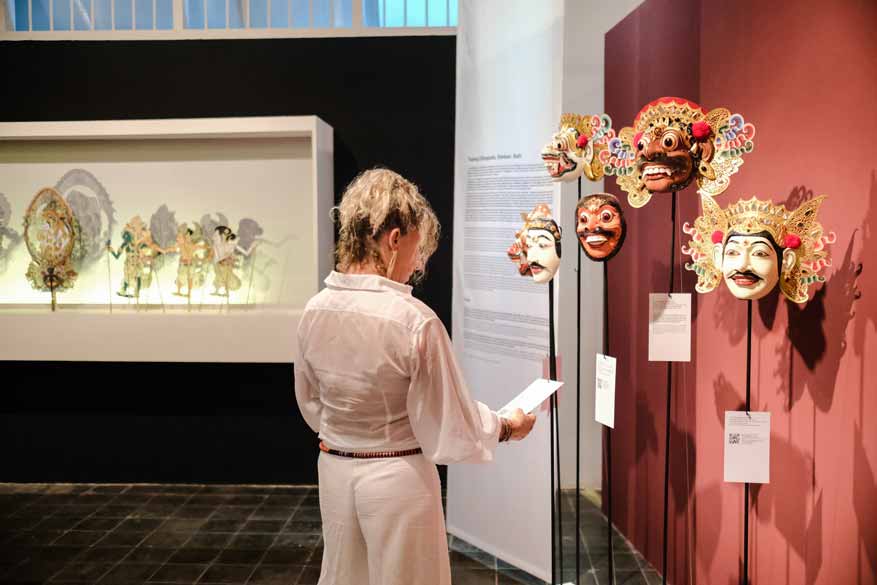
The one hundred and eighty-page booklet is an invaluable reference source containing a wealth of cultural knowledge and wisdom that helps distinguish Bali upon the global stage. One of the researched outcomes, mainly conducted from December 2020 to August 2021, involving engagements with artists, artisans, academics, researchers, design practitioners, culture lovers, collectors, policymakers, and students, the catalogue is essential reading for the curious, and lovers of Balinese culture.
“All the artists and artisans understand the importance of preserving their crafts and have valid concerns on the issue of regeneration because many of Bali’s youth choose to go into the tourism industry, which promises a better living, leaving behind their villages and their crafts. At the same time, each artist/artisan has differing perspectives on acknowledging the need to keep re-inventing new traditions to keep up with the times. Throughout our research, questions like, How to keep traditions alive? And, How can traditional crafts be sustainable? Reoccurred across all of the crafts we looked into.” Suriawati writes in the catalogue.
“Everyone agrees that natural pigments and dyes produce the best aesthetics and have Taksu (embodied energy), but as synthetic pigments and dyes which became readily available and more convenient to use, and as the craft’s commercialisation developed alongside cultural and ritual traditions, it is a natural development that many of the crafts have transitioned to using synthetic pigments and dyes. Furthermore, the scarcity of natural resources as the raw materials for some of the natural pigments and dyes means it is more expensive and difficult to get. Out of all the six crafts we are researching in the ‘Colors of Bali’ program only Gringsing textiles maintains the constant traditional use of natural dyes as the making of Gringsing is governed by strict rules according to its traditions.” Suriawati states.
Tourism has rapidly evolved during the past century. As a result, Balinese traditions have become increasingly vulnerable to and influenced by modernity. Therefore, issues regarding the sustainability of culture cannot escape our attention. A vital and timely investigation ‘Colors of Bali’ inevitably raises more questions than answers about Bali’s future and other associated dilemmas. In doing so, however, important subjects that touch our hearts and minds and inform the global community are immediately disseminated through digital interconnectivity.
The pandemic has signalled that we have arrived at the ultimate fork in the road. While scientists have been warning for decades that human actions are pushing life on our shared planet toward mass extinction, the dystopian future scenarios of Transhumanism and the Metaverse championed by Platform Capitalism giants Google and Facebook will accelerate the loss of traditional culture and destroy our reverence and connectivity with nature and the divine.
Bali is a unique example of a living tradition defined by distinct and valuable cultural expressions that can sustain a healthy collective ecosystem. This methodology seeks harmony between humanity and the forces of nature underlined by philosophies that help explain the mysteries of life according to the universal rhythms and laws. Our collective pathway forward is the preservation and regeneration of traditional cultures such as those presented in ‘Colors of Bali’ balanced with and enhanced by the positive creative aspects of digital technology.
‘Colors of Bali’ has been co-funded by CushCush Gallery and through the Australian Consulate-General in Bali and the Australia Awards Alumni Grant Scheme (AGS) administered by Australia Awards in Indonesia. Suriawati Qiu was a successful grantee of the Australian Alumni Grant Scheme in 2020. The exhibition presentation, design and research by CCG is fascinating and inspiring, triggering a sense of gratitude and awe for the Balinese. The Balinese and their incredible culture are often taken for granted by foreigners. It is, however, a unique portal into understanding our eternal relationship with nature and the cosmos, human creativity and potential.
‘Colors Of Bali – Rediscovering natural pigments & dyes in Balinese traditional crafts’
CushCush Gallery
Jalan Teuku Umar, Gang Rajawali no. 1A, Denpasar
(+62361) 242 034 | info@cushcushgallery.com
Instagram @cushcushgalllery
cushcushgallery.com

